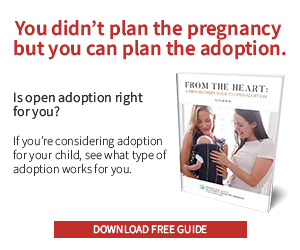Open adoptions can be beautiful and wonderful in so many ways. They allow the birth family to maintain a relationship with their biological child while he or she is being raised by you, his or her adoptive parents, in your home. As with all relationships, healthy boundaries are essential to maintaining healthy relationships among the adoption triad.
What are the Advantages of an Open Adoption?
There are a lot of wonderful benefits to having an open adoption for each person in the adoption triad. The birth parent can watch the child grow up with you. He or she can have peace of mind when seeing how well a biological child is doing in your home. He or she may also maintain a relationship with a child—which can be beneficial to both her and the adoptee.
As an adoptive parent, you can help give the birth parent peace of mind by having an open adoption. You also get the opportunity to have a relationship with your child’s birth parent. This relationship could develop into a close friendship that enriches your life as well as the birth parent’s. With an open adoption, you may have access to important information you wouldn’t have access to in a closed adoption. Specifically, you’ll be able to ask for information about the birth parent’s family and medical history–past and present. This information could be invaluable if your child gets sick.
Most importantly, open adoptions are beneficial for the adoptive child. Not only does your child get to be loved and cared for by you, but he or she also gets to be loved by his or her biological family through more personal experiences. As your child grows up, his or her birth family can provide important information. Your child’s birth parent can answer important questions about your child’s birth family, where he or she comes from, and why he or she was placed for adoption.
What are Boundaries?
A boundary is an invisible line that separates not only your physical space from others’, but also your needs, feelings, and responsibilities. When you set boundaries, you are telling other people how you want to be treated–what is acceptable behavior and what is not.
Why are Boundaries Important in Open Adoptions?
Boundaries are essential in open adoptions to help protect everyone’s well-being. Boundaries in open adoptions help define a birth family’s role versus the adoptive parents’ role. They help you be effective adoptive parents and allow the birth parent to more directly express her love to the child.
Boundaries are a good form of self-care. They allow you the space, time, and the energy you need to take care of yourself. When you take good care of yourself, you can be a more effective parent to your child.
Boundaries set expectations. When you are clear about your boundaries in an open adoption, a birth parent can have a better understanding of his or her role and what is expected. Boundaries also set expectations for you and your adopted child.
Discussing Boundaries Pre-Placement
It is absolutely essential that you sit down with the birth mother and discuss what type of relationship you want your adoptive child to have with his or her biological family before placement occurs. At a pre-placement meeting, discuss what types of contact you envision the birth parent having with the biological child and how often that contact may occur.
A birth parent should consider:
– What type of relationship do you want to have with your child?
– What type of contact would you like to have with your child? Would you like emails, phone calls, and/or visits? Do you want the adoptive parents to send you regular updates and photos through the mail?
– How often would you like to email, talk on the phone, and/or visit your child?
– How much information do you want your child to know about you and the rest of his or her biological family?
– If you live far away from the potential adoptive parents, where will you meet for visitations? Will you drive to the adoptive parents’ home? Will they drive to yours? Will you meet somewhere in the middle? How long will visits last?
– What can you realistically do? For instance, if you live far away from the potential adoptive parents, monthly visits may not be possible. If you don’t have Internet access, email updates aren’t the best way to stay in touch with the adoptive parents and your child.
When making an open adoption contact contract, the adoptive parents should consider:
– What kind of relationship do you want your child to have with his or her birth mother?
– What types and how much contact can you realistically commit to?
– How often will you revisit the terms of your open adoption contact agreement?
– Consider and discuss what might happen if certain life circumstances occur. What will happen if you or the birth mother moves further away or closer in proximity?
– Will you allow other people in your child’s birth family to visit your child along with the birth mother?
– Where will visits occur?
– When will visits occur?
– How long will visits last in duration?
– If you agree to other forms of contact such as emails, letter and photo updates, or phone calls, how often will this contact occur and at what frequency?
– Will you allow the birth mother to visit on special occasions such as your child’s birthday or at holidays?
Tips for Setting Up an Open Adoption Agreement
Be Clear: Each party needs to be open, honest, and clear about what they want post-placement. It is incredibly hard to be vulnerable and to ask for what you need and want, but it is vital that you state your needs and wishes during the creation of an open adoption agreement. You don’t want to keep your needs and wants to yourself at this time and end up regretful later. Take some time to think about what it is you need versus what you want. What can you live with and what is non-negotiable for you? These are important things to consider before sitting down to make an adoption agreement.
Don’t Overcommit: When you are creating your contact agreement, don’t overcommit. Adoptive parents shouldn’t agree to more visits, phone calls, or emails than they are happy with; they shouldn’t think that in a year or two the birth mother may want less contact. The agreement should state the minimum contact you all agree to have. You can always call, email, or visit more than the contract states if you wish.
Compromise: Compromises should be reached whenever possible. For instance, perhaps a birth mother wants to visit her child once a month whereas the adoptive parents were thinking about visits twice a year. They could compromise by agreeing to visits once every three months. Of course, both parties need to be comfortable with the compromise. If you are not comfortable with a compromise, don’t agree to it. Continue to discuss the issue until you can find some type of middle ground.
Pregnant and considering adoption?
Get your free adoption benefits and support bundle

Allow for Changes: Life happens. That’s why you need to allow for changes in your contact agreement in the future. Twice a year visitations might work for now, but if one party moves further away in the future, phone calls and video chats might be more practical than visits.
Determine how often you will revisit and revise your contact agreement. Revisiting the agreement annually allows enough time for everyone to see how well the current contact agreement is working and think about any changes they’d like to make.
Setting Boundaries Post-Placement
Even if part of your agreement is to revisit and revise every year, you may find yourself needing to set new or different boundaries post-placement. Even the clearest contract cannot possibly foresee every situation. No matter what the circumstances are, it’s important that you be able to set boundaries with the birth family post-placement when necessary.
Here are some tips for setting boundaries post-placement. You will notice that some of these tips are the same as setting boundaries pre-placement
Set Aside Time to Talk Without the Child: Unless the birth family is doing something that immediately endangers your child, make note of what boundary has been crossed in your mind. Decide whether the boundary violation is important enough to talk about. If it is, ask the birth parent to talk with you privately. This could be a phone conversation, video chat, or in-person meeting. I would suggest staying away from trying to address boundary issues via email or text message. Neither party can hear each other’s tone of voice in written communication, and this often leads to miscommunication and hurt feelings.
It’s important that you discuss any issues with the birth parent privately without your child present. Your child needs to have positive experiences with both you and his or her biological parent. Seeing tension between the two of you could cause your child to be confused, sad, or upset.
Set aside plenty of time for your phone call, video chat, or meeting. Set aside more time than you think you’ll need so you don’t have to rush through issues and have time to process your feelings.
Be Open, Honest, Clear, and Assertive: It’s tough to discuss issues in relationships. Before you talk to your child’s birth parent about any concerns you have, sit down and think about what you’d like to say. Use, “I” statements whenever possible instead of, “you” statements. “You” statements easily put others on the defensive and can hinder them from hearing what you are trying to convey.
For instance, if you see your child’s birth mother trying to correct your child’s behavior instead of allowing you to handle the situation, it’s not a good idea to say, “You shouldn’t be parenting your biological child. That’s my job!” Instead, try saying something like, “I understand that you were trying to help our child by correcting his or her behavior, and I appreciate you wanting to lend a helping hand. Please remember that my role in our child’s life is to parent him or her. I feel it is confusing for our child when you try to parent him or her. If you have concerns about my parenting style, you can voice those to me privately.”
Open, honest, and clear communication is the foundation of a good relationship between you and your child’s birth mother. It won’t always be easy, but setting boundaries in a clear and direct way will benefit everyone involved.
Allow Your Child to Have a Say: As your child grows up, he or she should have a say in how often he or she sees the birth parent(s). The whole point of an open adoption is to benefit the child, so if too many visits or phone calls are upsetting your child, it may be time to revisit your contact agreement. Likewise, if your child wants to see his or her birth mother more frequently, you should take that into consideration.
Say No When You Need To: If the birth parent makes a request you aren’t comfortable with or can’t meet, it is perfectly okay to say no. For example, perhaps your contact agreement states that the birth mother can visit your child on his or her birthday month, but not on his or her birthday specifically. The birth mother asks you if she can visit on your child’s birthday this year. If you aren’t comfortable with that, simply remind her that she is welcome to visit on another day in your child’s birth month.
There is no need to feel guilty about saying no when you need to. This can be incredibly difficult for people pleasers. Remember that taking care of yourself and your child needs to be a priority and sometimes that means saying no to things.
Seek Help if Needed: If you try to set boundaries but the birth mother doesn’t respect them, or if you are having trouble setting boundaries, it may be time to seek some outside help. Your adoption professional is a great resource and can help you create boundaries in your open adoption relationship. A therapist or counselor well-versed in adoption issues is another good resource.
Boundaries are an important part of having a healthy relationship with your child’s birth parent. Though it may feel awkward discussing them, boundaries set expectations and allow the birth parent an opportunity to have a relationship with your child as he or she grows up. When healthy boundaries are in place, an adoptee is able to reap the benefits of open adoption.


